Approaches to Failure Risk Analysis of the Water Distribution Network with Regard to the Safety of Consumers
Abstract
1. Introduction
2. Legal Regulations Regarding Safety of the Water Supply for Consumers
3. Materials and Methods
3.1. The Failure Risk Approaches of Failure Framework and Data Source
- type of a water pipe (mains, distribution or service connections),
- months in which the network was damaged.
3.2. Description of the Study Area
3.3. Characteristics of the Research Object
3.4. Methods
3.4.1. Failure Rate Analysis
3.4.2. A Rank Analysis of Failure-Rate Criteria
3.4.3. Seasonal Analysis of Failure Rates
- the seasonal index Si given by:
- absolute levels of seasonal fluctuations for individual sub-periods, calculated using:
- the standard deviation (SD) characterizing absolute levels of seasonal variation, with these representing an assessment of variability due to the factor of season over a period of 13 years in operation:
3.4.4. A Proposed Modified Multi-Criteria Decision Analysis Implementing an Analytic Hierarchy Process for Risk Assessment as Regards Failures in a WDN
4. Results and Discussion
4.1. Failure Rate Analysis
4.2. Results of Failure Risk Assessment for WDN
5. Conclusions and Perspectives
Author Contributions
Funding
Conflicts of Interest
References
- Rak, J.R.; Tchórzewska-Cieślak, B. Risk in Operation of Collective Water Supply Systems; Publishing House of Seidel Przywecki: Warsaw, Poland, 2013. [Google Scholar]
- Rak, J. Safety of Water Supply System; Polish Academy of Science: Warsaw, Poland, 2009. [Google Scholar]
- Rak, J.; Tchórzewska-Cieślak, B. Risk Factors in the Operation of Water Supply Systems; Publishing House of Rzeszow University of Technology: Rzeszow, Poland, 2007. [Google Scholar]
- Rak, J. Fundamentals of Water Supply System Safety; Polish Academy of Science: Lublin, Poland, 2005. [Google Scholar]
- Rak, J. A study of the qualitative methods for risk assessment in water supply systems. Environ. Prot. Eng. 2003, 29, 123–133. [Google Scholar]
- Rak, J.R. Some aspects of risk management in waterworks. Ochr. Sr. 2007, 29, 61–64. [Google Scholar]
- Rak, J.; Tchórzewska-Cieślak, B. The possible use of the FMEA method to ensure health safety of municipal water. J. Konbin 2010, 3, 143–154. [Google Scholar] [CrossRef]
- Rak, J.R. Methods of reliability index determination concerning municipal water quality. J. Konbin 2008, 5, 157–173. [Google Scholar] [CrossRef]
- Tchórzewska-Cieślak, B. Methods for Analysis and Assessment of Risk of Failure in Water Distribution Subsystem; Publishing House of Rzeszow University of Technology: Rzeszow, Poland, 2011. [Google Scholar]
- Salehi, S.; Tabesh, M.; Ghazizadeh, M.J. HRDM method for rehabilitation of pipes in water distribution networks with inaccurate operational-failure data. J. Water Res. Plan. Manag. 2018, 144. [Google Scholar] [CrossRef]
- Pagano, A.; Pluchinotta, I.; Giordano, R.; Petrangeli, A.B.; Fratino, U.; Vurro, M. Dealing with uncertainty in decision-making for drinking water supply systems exposed to extreme events. Water Res. Manag. 2018, 32, 2131–2145. [Google Scholar] [CrossRef]
- Tchorzewska-Cieslak, B.; Rak, J. Method of identification of operational states of water supply system. Environmental Engineering III. In Proceedings of the 3rd Congress of Environmental Engineering, Pafos, Cyprus, 13–16 September 2009; pp. 521–526. [Google Scholar]
- Izquierdo, J.; López, P.A.; Martinéz, F.A.; Pérez, R. Fault detection in water supply systems using hybrid (theory and data-driven) modeling. Math. Comput. Model. 2007, 46, 341–350. [Google Scholar] [CrossRef]
- Khomsi, B.D.; Walters, G.A.; Thorley, A.R.D.; Ouazar, D. Reliability tester for water distribution networks. J. Comput. Civ. Eng. 1996, 10, 10–19. [Google Scholar] [CrossRef]
- Tchorzewska-Cieslak, B.; Wlodarczyk-Makula, M.; Rak, J. Safety analysis of the wastewater treatment process in the field of organic pollutants including PAHs. Desalin. Water Treat. 2017, 72, 146–155. [Google Scholar] [CrossRef]
- Bergel, T.; Pawełek, J. Quantitative and economical aspects of water loss in water-pipe networks in rural areas. Environ. Prot. Eng. 2008, 34, 59–64. [Google Scholar]
- Zimoch, I. Pressure control as part of risk management for a water-pipe network in service. Ochr. Sr. 2012, 34, 57–62. [Google Scholar]
- Kuliczkowski, A.; Kuliczkowska, E.; Kubicka, U. Design of the pipelines considering exploitative parameters. Underground Infrastructure of Urban Areas. In Proceedings of the International Conference on Underground Infrastructure of Urban Areas, Wroclaw, Poland, 22–24 October 2008; pp. 165–170. [Google Scholar]
- Pozos-Estrada, O.; Sanchez-Huerta, A.; Brena-Naranjo, J.A.; Pedrozo-Acuna, A. Failure analysis of a water supply pumping pipeline system. Water 2016, 8. [Google Scholar] [CrossRef]
- Wąsik, E.; Chmielowski, K.; Cupak, A.; Kaczor, G. Stability monitoring of the nitrification process: Multivariate statistical analysis. Pol. J. Environ. Stud. 2018, 27, 2303–2313. [Google Scholar] [CrossRef]
- Królikowska, J. Application of PHA method for assessing risk of failure on the example of sewage system in the City of Krakow. Rocz. Ochr. Sr. 2011, 13, 693–710. [Google Scholar]
- Berardi, L.; Ugarelli, R.; Rostum, J.; Giustolisi, O. Assessing mechanical vulnerability in water distribution networks under multiple failures. Water Resour. Res. 2014, 50, 2586–2599. [Google Scholar] [CrossRef]
- Kozłowski, E.; Mazurkiewicz, D.; Kowalska, B.; Kowalski, D. Application of a multidimensional scaling method to identify the factors influencing on reliability of deep wells. Adv. Intell. Syst. 2019, 835, 56–65. [Google Scholar] [CrossRef]
- Tchórzewska-Cieślak, B.; Boryczko, K.; Eid, M. Failure scenarios in water supply system by means of fault tree analysis. In Advances in Safety, Reliability and Risk Management; Taylor & Francis Group: Abingdon, UK, 2012; pp. 2492–2499. [Google Scholar]
- Zimoch, I. Method of risk analysis and assessment of water supply system exploitation in agricultural areas. Ochr. Sr. 2016, 38, 33–38. [Google Scholar]
- Puri, D.; Borel, K.; Vance, C.; Karthikeyan, R. Optimization of a water quality monitoring network using a spatially referenced water quality model and a genetic algorithm. Water 2017, 9. [Google Scholar] [CrossRef]
- Jung, D.; Yoo, D.; Kang, D.; Kim, J. Linear model for estimating water distribution system. J. Water Res. Plan. Manag. 2016, 142, 04016022. [Google Scholar] [CrossRef]
- Moglia, M.; Davis, P.; Burn, S. Strong exploration of a cast iron pipe failure model. Reliab. Eng. Syst. Saf. 2008, 93, 863–874. [Google Scholar] [CrossRef]
- Wang, Y.; Zayed, T.; Moselhi, O. Prediction models for annual break rates of water mains. J. Perform. Constr. Fac. 2009, 23, 47–54. [Google Scholar] [CrossRef]
- Zimoch, I.; Łobos, E. Application of the theil statistics to the calibration of a dynamic water supply model. Environ. Prot. Eng. 2010, 36, 105–115. [Google Scholar]
- Mamo, T.G. Risk-based approach to manage aging urban water main infrastructure. J. Water Supply Res. Technol. 2015, 64, 260–269. [Google Scholar] [CrossRef]
- Shahata, K.; Zayed, T. Data acquisition and analysis for water main rehabilitation techniques. Struct. Infrastruct. E 2012, 8, 1054–1066. [Google Scholar] [CrossRef]
- Scheidegger, A.; Scholten, L.; Maurer, M.; Reichert, P. Extension of pipe failure models to consider the absence of data from replaced pipes. Water Res. 2013, 11, 3696–3705. [Google Scholar] [CrossRef] [PubMed]
- Tabesh, M.; Soltani, J.; Farmani, R.; Savic, D. Assessing pipe failure rate and mechanical reliability of water distribution networks using data-driven modeling. J. Hydroinform. 2009, 11, 1–17. [Google Scholar] [CrossRef]
- D’Ercole, M.; Righetti, M.; Raspati, G.S.; Bertola, P.; Ugarelli, R.M. Rehabilitation planning of water distribution network through a reliability-based risk assessment. Water 2018, 10. [Google Scholar] [CrossRef]
- Iwanejko, R.; Bajer, J. Determination of the optimum number of repair units for water distribution systems. Arch. Civ. Eng. 2009, 55, 87–101. [Google Scholar]
- Martinez-Codina, A.; Castillo, M.; Gonzales-Zeas, D.; Garrote, L. Pressure as a predictor of occurrence of pipe breaks in water distribution networks. Urban Water J. 2016, 13, 676–686. [Google Scholar] [CrossRef]
- Królikowska, J. Damage evaluation of a town’s sewage system in southern poland by the preliminary hazard analysis method. Environ. Prot. Eng. 2011, 37, 131–142. [Google Scholar]
- Szpak, D.; Tchórzewska-Cieslak, B. Assessment of the failure rate of water supply system in terms of safety of critical infrastructure. Chemik 2014, 6, 862–867. [Google Scholar]
- Darvini, G. Comparative analysis of different probability distributions of random parameters in the assessment of water distribution system reliability. J. Hydroinform. 2014, 14, 272–287. [Google Scholar] [CrossRef]
- Boxall, J.B.; O’Hagan, A.; Pooladsaz, S.; Saul, A.J.; Unwin, D.M. Estimation of burst rates in water distribution mains. Proc. Inst. Civ. Eng.-Water Manag. 2007, 160, 73–82. [Google Scholar] [CrossRef]
- Shin, H.; Kobayashi, K.; Koo, J.; Do, M. Estimating burst probability of water pipelines with a competing hazard model. J. Hydroinform. 2016, 18, 126–135. [Google Scholar] [CrossRef]
- Arai, Y.; Koizumi, A.; Inakazu, T.; Watanabe, H.; Fujiwara, M. Study on failure rate analysis for water distribution pipelines. J. Water Supply Res. Technol. 2010, 59, 429–435. [Google Scholar] [CrossRef]
- Hotloś, H. Quantitative Assessment of the Effect of Some Factors on the Parameters and Operating Costs of Water-Pipe Networks; Wrocław University of Technology Publishing House: Wrocław, Poland, 2007. [Google Scholar]
- Estokova, A.; Ondrejka Harbulakova, V.; Luptakova, A.; Stevulova, N. Performance of fiber-cement boards in biogenic sulphate environment. Adv. Mater. Res. 2014, 897, 41–44. [Google Scholar] [CrossRef]
- Hotlos, H. Quantitative assessment of the influence of water pressure on the reliability of water-pipe networks in service. Environ. Prot. Eng. 2010, 36, 103–112. [Google Scholar]
- Bogardi, I.; Fülöp, R. A Spatial probabilistic model of pipeline failures. Period Polytech.-Civ. 2011, 55, 161–168. [Google Scholar] [CrossRef]
- Debón, A.; Carrión, A.; Cabrera, E.; Solano, H. Comparing risk of failure models in water supply networks using ROC curves. Reliab. Eng. Syst. Saf. 2010, 95, 43–48. [Google Scholar] [CrossRef]
- Kleiner, Y.; Rajani, B. Comprehensive review of structural deterioration of water mains: Statistical models. Urban Water J. 2001, 3, 131–150. [Google Scholar] [CrossRef]
- Kowalski, D.; Kowalska, B.; Kwietniewski, M. Monitoring of water distribution system effectiveness using fractal geometry. Bull. Pol. Acad. Sci. 2015, 63, 155–161. [Google Scholar] [CrossRef]
- Kutyłowska, M. Comparison of two types of artificial neural networks for predicting failure frequency of water conduits. Period Polytech.-Civ. 2017, 61, 1–6. [Google Scholar] [CrossRef]
- Kwietniewski, M.; Rak, J. Reliability of Water and Wastewater Infrastructure in Poland; Polish Academy of Science: Warsaw, Poland, 2010. [Google Scholar]
- Mays, W.L. Reliability Analysis of Water Distribution Systems; American Society of Civil Engineers: New York, NY, USA, 1998. [Google Scholar]
- Pelletier, G.; Mailhot, A.; Villeneuve, J.P. Modeling water pipe breaks-three case studies. J. Water Res. Plan. Manag. 2003, 129, 115–123. [Google Scholar] [CrossRef]
- Shamir, U.; Howard, C.D.D. An analytical approach to scheduling pipe replacement. J. Am. Water Works Assoc. 1979, 71, 248–258. [Google Scholar] [CrossRef]
- Toumbou, B.; Villeneuve, J.P.; Beardsell, G.; Duchesne, S. General model for water-distribution pipe breaks: Development, methodology, and application to a small city in Quebec, Canada. J. Pipeline Syst. Eng. 2014, 5, 04013006. [Google Scholar] [CrossRef]
- Xu, Q.; Chen, Q.; Li, W. Application of genetic programming to modeling pipe failures in water distribution systems. J. Hydroinform. 2011, 13, 419–428. [Google Scholar] [CrossRef]
- Shuang, Q.; Liu, Y.S.; Tang, Y.Z.; Liu, J.; Shuang, K. System reliability evaluation in water distribution networks with the impact of valves experiencing cascading failures. Water 2017, 9. [Google Scholar] [CrossRef]
- Rak, J.R.; Kucharski, B. Sludge management in water treatment plants. Environ. Prot. Eng. 2009, 35, 15–21. [Google Scholar]
- Walski, T.M.; Pelliccia, A. Economic analysis of water main breaks. J. Am. Water Works Assoc. 1982, 74, 140–147. [Google Scholar] [CrossRef]
- Tchórzewska-Cieślak, B.; Pietrucha-Urbanik, K.; Urbanik, M.; Rak, J.R. Approaches for safety analysis of gas-pipeline functionality in terms of failure occurrence: A case study. Energies 2018, 11, 1589. [Google Scholar] [CrossRef]
- Nowacka, A.; Wlodarczyk-Makula, M.; Tchorzewska-Cieslak, B.; Rak, J. The ability to remove the priority PAHs from water during coagulation process including risk assessment. Desalin. Water Treat. 2016, 57, 1297–1309. [Google Scholar] [CrossRef]
- Seo, J.; Koo, M.; Kim, K.; Koo, J. A study on the probability of failure model based on the safety factor for risk assessment in a water supply network. Procedia Eng. 2015, 119, 206–215. [Google Scholar] [CrossRef]
- StatSoft, Inc. STATISTICA (Data Analysis Software System), Version 12. Available online: www.statsoft.com (accessed on 15 July 2018).
- Kwietniewski, M.; Roman, M.; Kłos-Trębaczkiewicz, H. Relaibility of Water Supply and Sewage Systems; Arkady: Warsaw, Poland, 1993. [Google Scholar]
- Wieczysty, A. Reliability of Water and Wastewater Systems I and II; Publishing House of Cracow University of Technology: Kraków, Poland, 1990. [Google Scholar]
- Kwietniewski, M. Failure of water supply and wastewater infrastructure in Poland based on the field tests. In Proceedings of the XXV Scientific-Technical Conference, Międzyzdroje, Poland, 24–27 May 2011; pp. 12–140. [Google Scholar]
- Corder, G.W.; Foreman, D.I. Nonparametric Statistics: A Step-by-Step Approach; Wiley: Hoboken, NJ, USA, 2014. [Google Scholar]
- Sobczyk, M. Statistics: Theoretical and Practical Aspects; Maria Curie-Sklodowska University (UMCS): Lublin, Poland, 2006. [Google Scholar]
- Figueira, J.; Greco, S.; Ehrgott, M. Multicriteria Decision Analysis: State of the Art Surveys; Springer: New York, NY, USA, 2005. [Google Scholar] [CrossRef]
- Tchórzewska-Cieślak, B.; Pietrucha-Urbanik, K. Methods for integrated failure risk analysis of water network in terms of water supply system functioning management. J. Pol. Saf. Reliab. Assoc. 2017, 8, 157–166. [Google Scholar]
- Saaty, L.T. A scaling method for priorities in hierarchical structures. J. Math. Psychol. 1977, 15, 234–281. [Google Scholar] [CrossRef]
- Saaty, L.T. The Analytic Hierarchy Process; McGraw-Hill: New York, NY, USA, 1980. [Google Scholar]

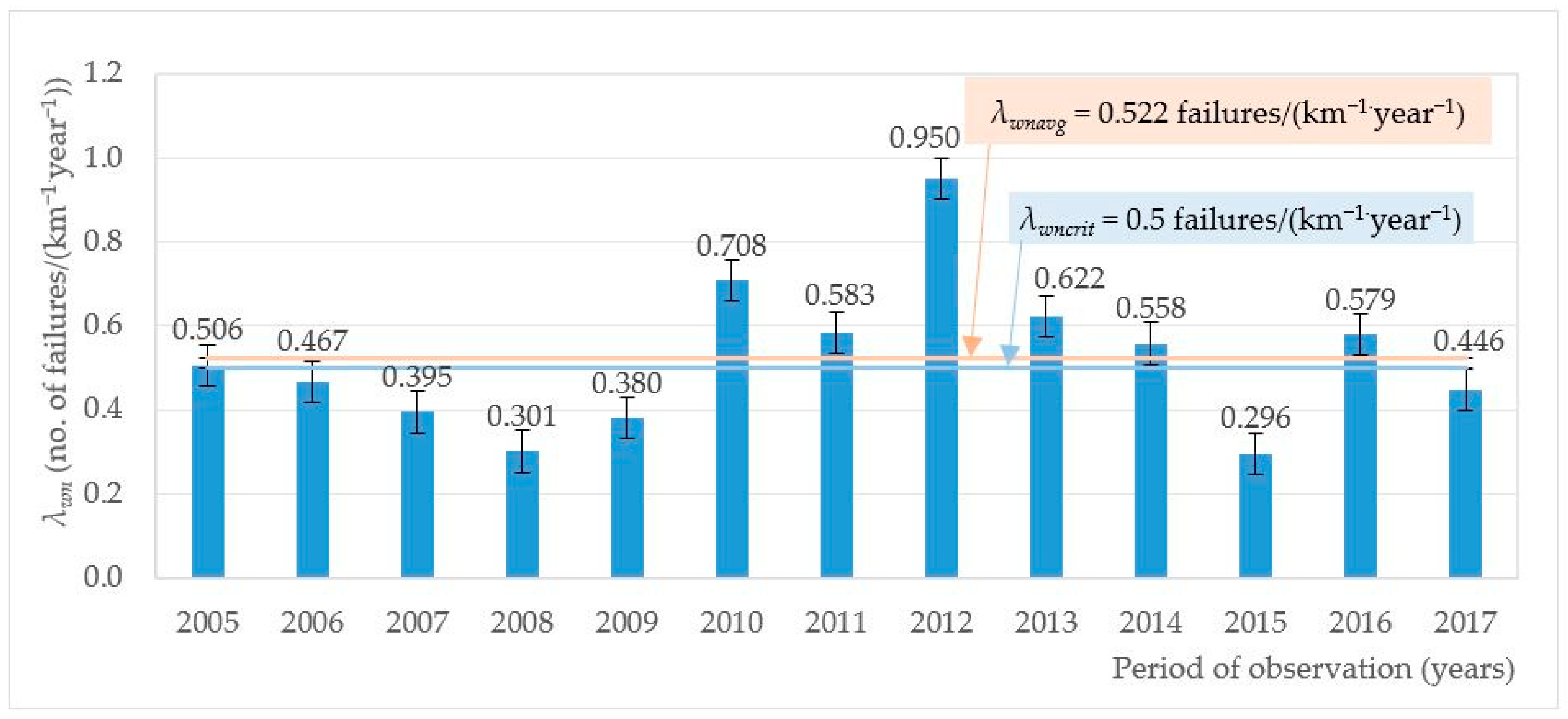

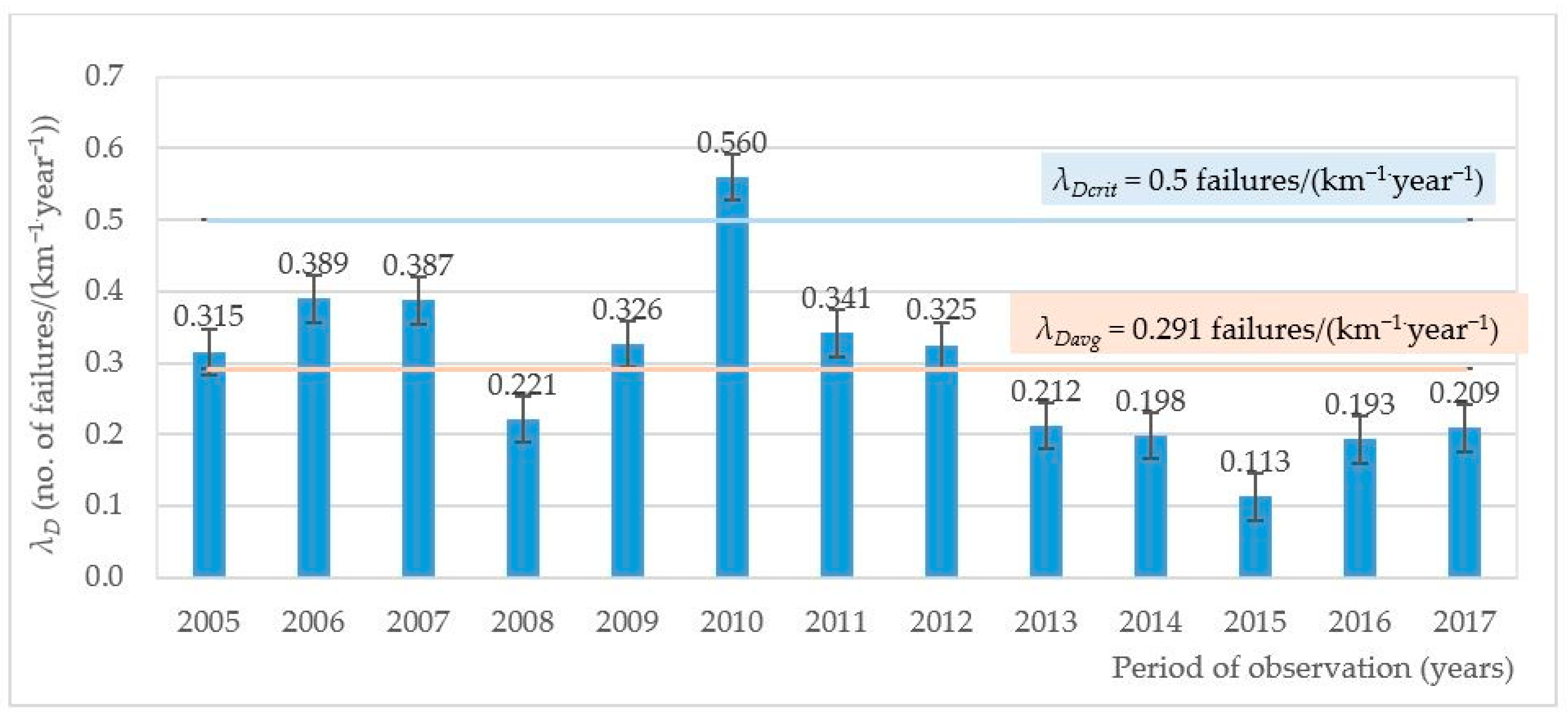
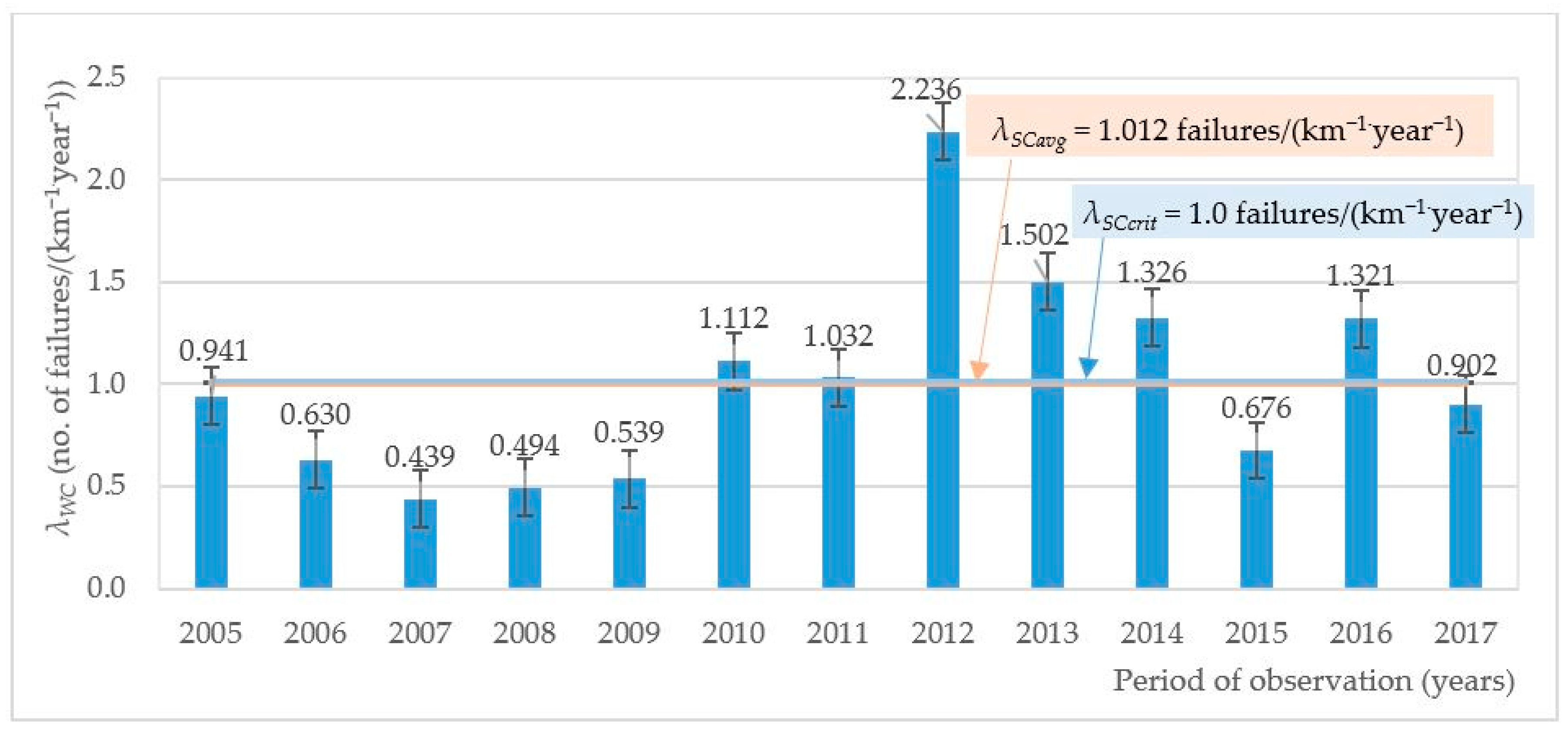
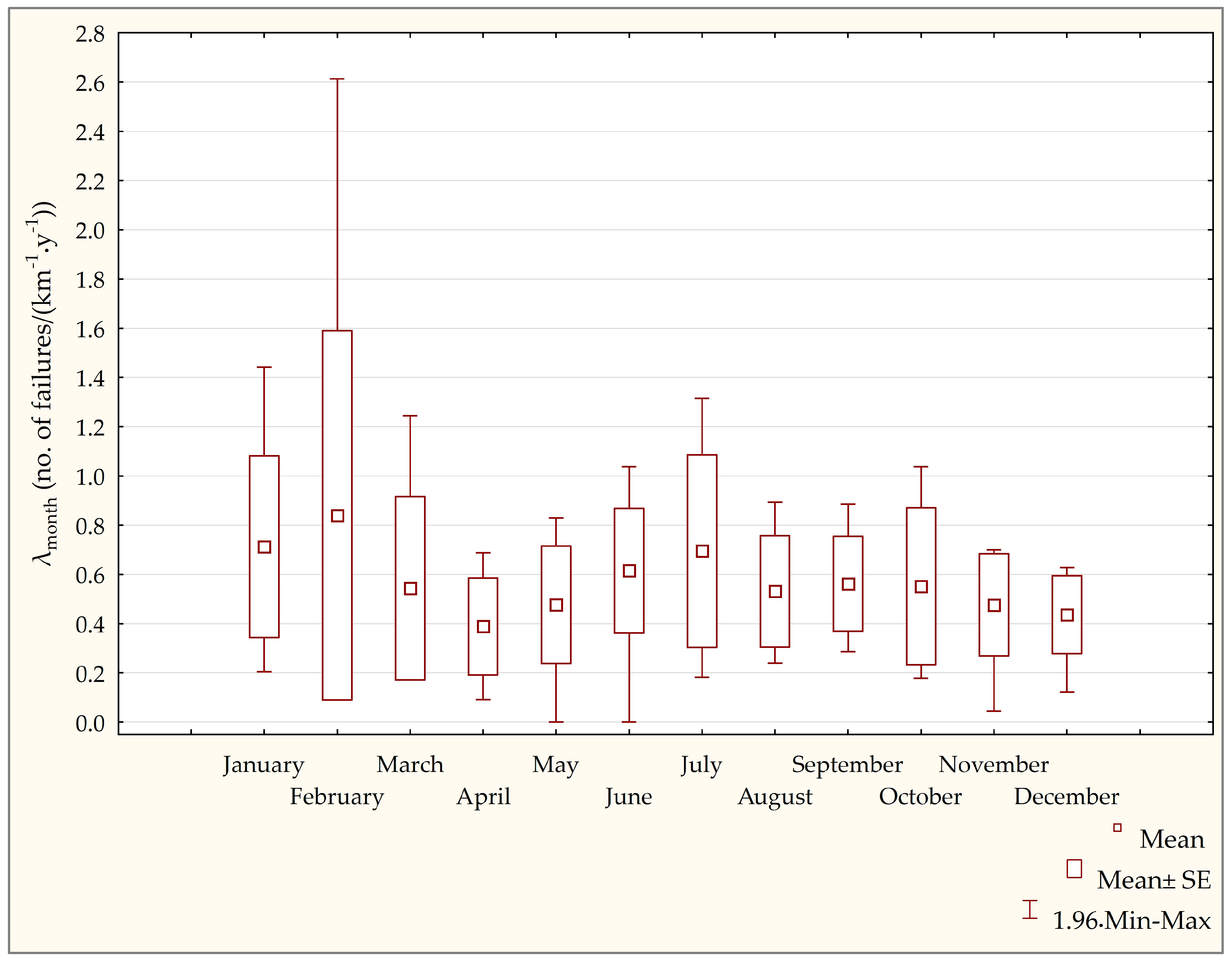
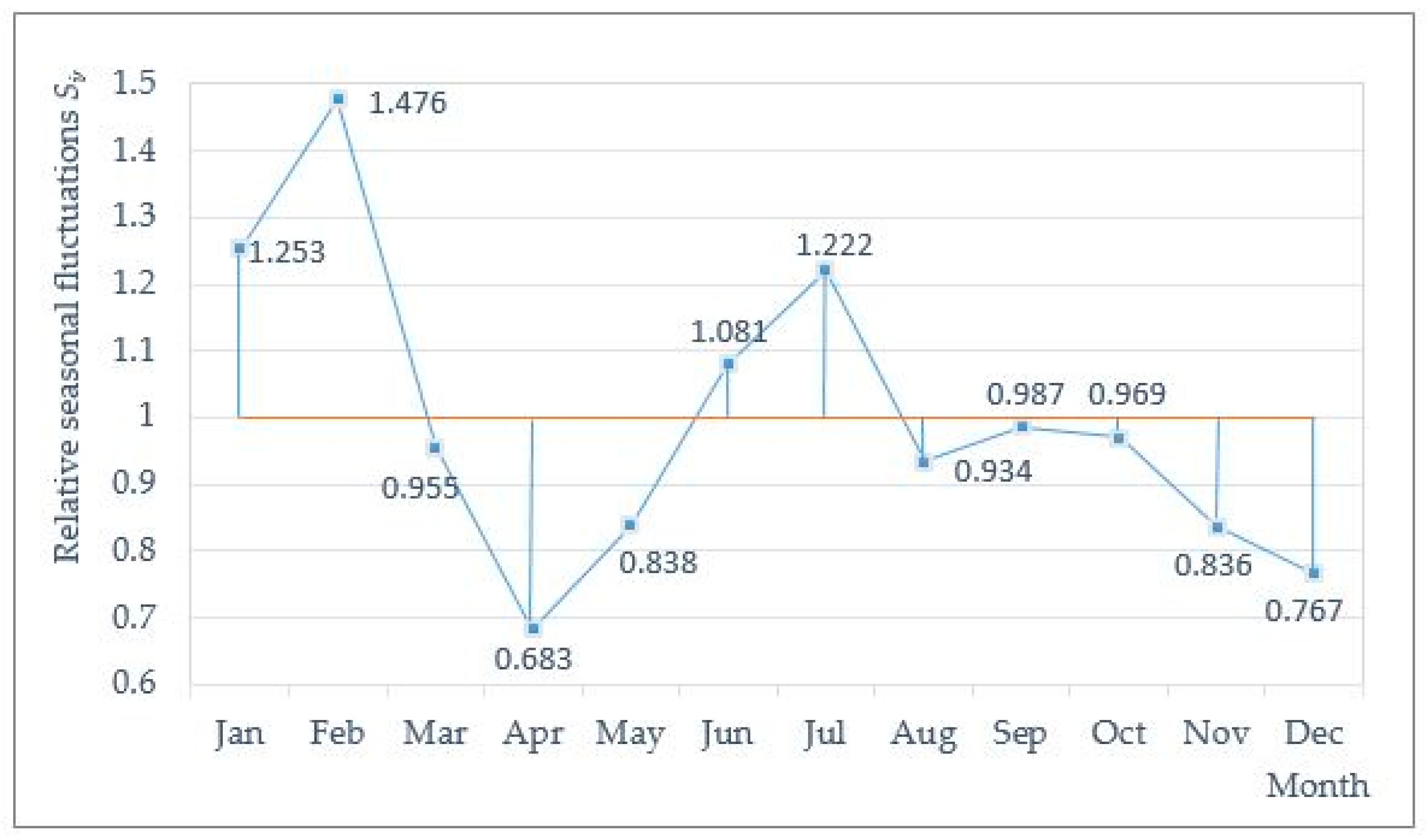
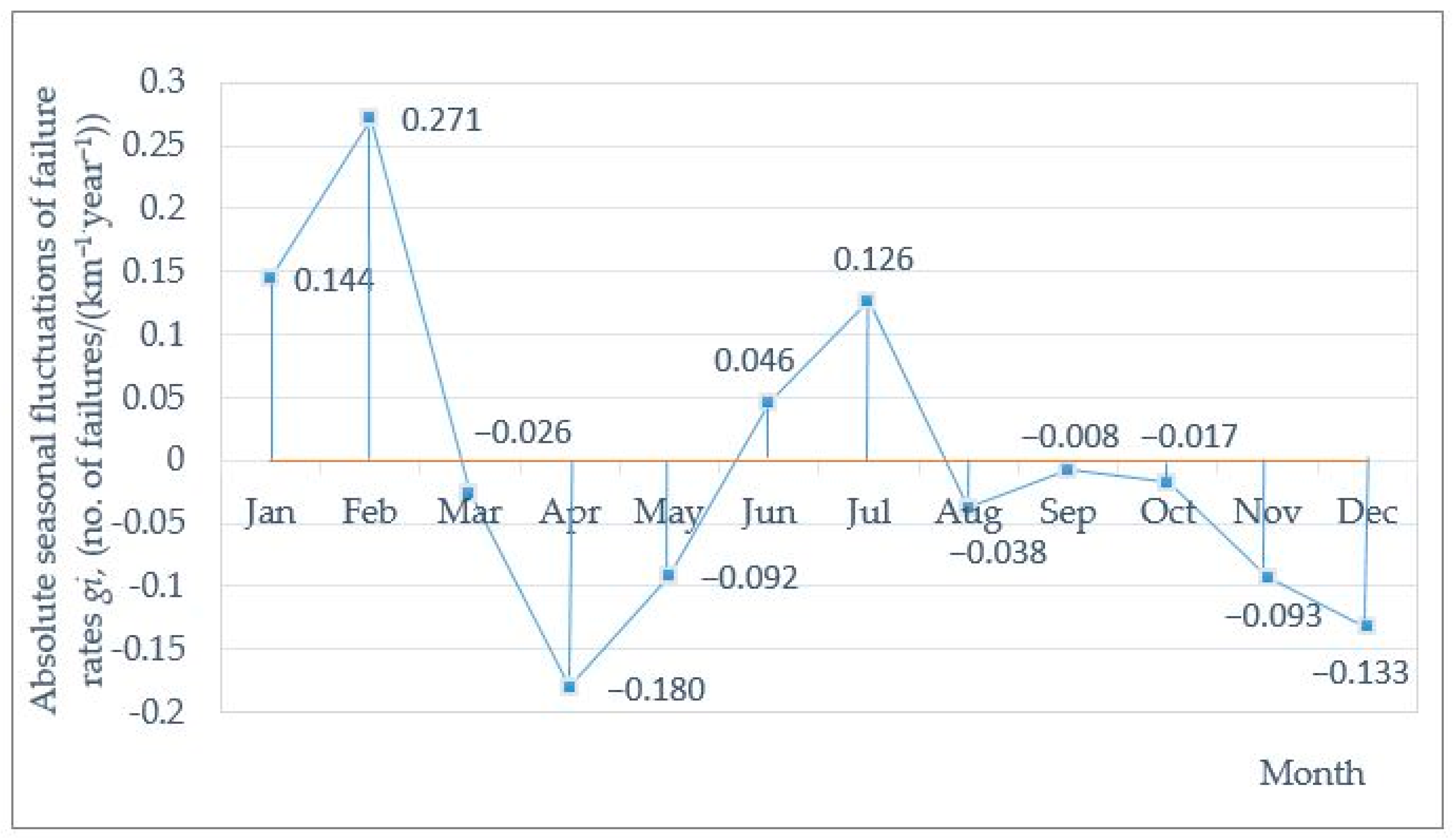
| Interpretation | Value of aij | Definition | |
|---|---|---|---|
| 1 | 1 | i and j are equally important | equal importance |
| 3 | 1/3 | i is slightly more important than j | moderate importance |
| 5 | 1/5 | i is more important than j | strong importance |
| 7 | 1/7 | i is far more important than j | very strong or demonstrated importance |
| 9 | 1/9 | i is absolutely more important than j | extreme importance |
| 2, 4, 5, 8 | 1/2, 1/4, 1/5, 1/8 | intermediate values | for comprise between the above values |
| n | 3 | 4 | 5 | 6 | 7 | 8 | 9 | 10 | 11 | 12 |
|---|---|---|---|---|---|---|---|---|---|---|
| RI | 0.52 | 0.89 | 1.11 | 1.25 | 1.35 | 1.40 | 1.45 | 1.49 | 1.52 | 1.54 |
| No. | Categories and Subcategories of Criteria | Point Weighting of Subcategories | |||
|---|---|---|---|---|---|
| 1 | 2 | 3 | 4 | 5 | |
| I | Ia) | Design | a reputable design office with a quality certificate, having completed projects on the reference list, and engaging in design using proven computer programs, | 1 | |
| Ib) | design office has certified designs and legitimizes itself by virtue of a list of references, | 2 | |||
| Ic) | a person engaging in business activity, having in his portfolio partial projects for the expansion of WDN, | 3 | |||
| Id) | network monitoring * | above-standard, | 1 | ||
| Ie) | standard, | 2 | |||
| If) | none, | 3 | |||
| Ig) | corrosion protection | full, | 1 | ||
| Ih) | standard, | 2 | |||
| Ii) | none, | 3 | |||
| II | IIa) | Performance | construction company is certified and has completed investments in the reference list, procedures related to the acceptance of investments, pipes laid in accordance with the best available technology, | 1 | |
| IIb) | construction company has a reference list of completed investments, verification of material specifications and acceptance procedures is performed, | 2 | |||
| IIc) | construction company is entering the water supply market, but has no experience in this area, | 3 | |||
| III | IIIa) | Operation | type of WDN according to higher priority to repair | SC, | 1 |
| IIIb) | distribution network, | 2 | |||
| IIIc) | mains, | 3 | |||
| IIId) | failure rate, λ | to 0.5 km−1∙year−1, | 1 | ||
| IIIe) | from 0.5 km−1∙year−1 to 1.0 km−1∙year−1, | 2 | |||
| IIIf) | >1.0 km−1∙year−1, | 3 | |||
| IIIg) | dynamic loads, including difficulty of repairs in area in which a network is situated | pipeline in non-urbanized areas, | 1 | ||
| IIIh) | pipeline in pedestrian traffic (under pavements), | 2 | |||
| IIIi) | pipeline in the street, | 3 | |||
| IIIj) | WDN age | to 20 years, | 1 | ||
| IIIk) | from 20 to 50 years, | 2 | |||
| IIIl) | above 50 years, | 3 | |||
| IIIm) | WDN material | plastics, | 1 | ||
| IIIn) | steel, | 2 | |||
| IIIo) | grey cast iron, | 3 | |||
| IV | IVa) | Social | nuisance resulting from road occupation and green area | pipeline in non-urbanized area, | 1 |
| IVb) | pipeline in pedestrian traffic, | 2 | |||
| IVc) | pipeline in street, | 3 | |||
| V | Va) | Financial | size of possible losses arising should failure occur | financial loss of up to 104 EUR, | 1 |
| Vb) | financial loss from 104 to 105 EUR, | 2 | |||
| Vc) | financial loss above 105 EUR, | 3 | |||
| Vd) | difficulty of repairing damage | repair brigades are organized and equipped appropriately and are in full readiness for 24 h, | 1 | ||
| Ve) | basic equipment to repair a failure, one-shift work, | 2 | |||
| Vf) | lack of mechanized equipment to repair a failure, | 3 | |||
| VI | VIa) | Environment and surroundings | hydrogeological conditions | good, | 1 |
| VIb) | average, | 2 | |||
| VIc) | poor, | 3 | |||
| VId) | density of underground infrastructure in the vicinity of the network | low, | 1 | ||
| VIe) | average, | 2 | |||
| VIf) | high. | 3 | |||
| Category | I | II | III | IV | V | VI | Weight |
|---|---|---|---|---|---|---|---|
| I | 1 | 2 | 2 | 4 | 4 | 3 | 0.3262 |
| II | 0.5 | 1 | 2 | 4 | 4 | 3 | 0.2589 |
| III | 0.5 | 0.5 | 1 | 4 | 3 | 3 | 0.1959 |
| IV | 0.25 | 0.25 | 0.25 | 1 | 2 | 2 | 0.0856 |
| V | 0.25 | 0.25 | 0.333 | 0.5 | 1 | 2 | 0.0712 |
| VI | 0.333 | 0.333 | 0.333 | 0.5 | 0.5 | 1 | 0.0622 |
| Total | 2.833 | 4.333 | 5.917 | 14 | 14.5 | 14 | 0.3262 |
| λmax = 6.3071; CI = 0.0614; RI = 1.25; CR = 0.0491 | |||||||
| No. | Categories and Subcategories of Criteria | Weight | ||||
|---|---|---|---|---|---|---|
| Point Weight of Subcategories | Categories | |||||
| 1 | 2 | 3 | 4 | 5 | 6 | |
| I | Ib) | Designing | design office has certified designs and legitimizes itself by virtue of a list of references, | 2 | 0.3262 | |
| Ie) | network monitoring | standard, simplified monitoring of water- WDN with the use of pressure measurement, | 2 | 0.3262 | ||
| Ii) | corrosion protection | not applicable | 3 | 0.3262 | ||
| II | IIb) | Performance | construction company has a reference list of completed investments, verification of material specifications and acceptance procedures is performed, | 2 | 0.2589 | |
| III | IIIb) | Operation | type of WDN | distribution network, | 2 | 0.1959 |
| IIId) | failure rate, λ | to 0.5 km−1∙year−1, | 1 | 0.1959 | ||
| IIIg) | dynamic loads | pipeline in not urbanized areas, | 1 | 0.1959 | ||
| IIIk) | WDN age | from 20 to 50 years, | 2 | 0.1959 | ||
| IIIm) | WDN material | plastics, | 1 | 0.1959 | ||
| IV | IVa) | Social | nuisance of road and green area users | pipeline in non-urbanized area, | 1 | 0.0856 |
| V | Va) | Financial | size of possible losses arising should failure occur | financial loss of up to 104 EUR, | 1 | 0.0712 |
| Ve) | difficulty of repairing damage | basic equipment to repair a failure, one-shift work, | 2 | 0.0712 | ||
| VI | VIc) | Environment and surroundings | hydrogeological conditions | poor, | 3 | 0.0622 |
| VId) | density of underground infrastructure in the vicinity of the network | low. | 1 | 0.0622 | ||
© 2018 by the authors. Licensee MDPI, Basel, Switzerland. This article is an open access article distributed under the terms and conditions of the Creative Commons Attribution (CC BY) license (http://creativecommons.org/licenses/by/4.0/).
Share and Cite
Pietrucha-Urbanik, K.; Tchórzewska-Cieślak, B. Approaches to Failure Risk Analysis of the Water Distribution Network with Regard to the Safety of Consumers. Water 2018, 10, 1679. https://doi.org/10.3390/w10111679
Pietrucha-Urbanik K, Tchórzewska-Cieślak B. Approaches to Failure Risk Analysis of the Water Distribution Network with Regard to the Safety of Consumers. Water. 2018; 10(11):1679. https://doi.org/10.3390/w10111679
Chicago/Turabian StylePietrucha-Urbanik, Katarzyna, and Barbara Tchórzewska-Cieślak. 2018. "Approaches to Failure Risk Analysis of the Water Distribution Network with Regard to the Safety of Consumers" Water 10, no. 11: 1679. https://doi.org/10.3390/w10111679
APA StylePietrucha-Urbanik, K., & Tchórzewska-Cieślak, B. (2018). Approaches to Failure Risk Analysis of the Water Distribution Network with Regard to the Safety of Consumers. Water, 10(11), 1679. https://doi.org/10.3390/w10111679





